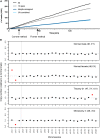Rapid Multiplex Small DNA Sequencing on the MinION Nanopore Sequencing Platform
- PMID: 29540443
- PMCID: PMC5940156
- DOI: 10.1534/g3.118.200087
Rapid Multiplex Small DNA Sequencing on the MinION Nanopore Sequencing Platform
Abstract
Real-time sequencing of short DNA reads has a wide variety of clinical and research applications including screening for mutations, target sequences and aneuploidy. We recently demonstrated that MinION, a nanopore-based DNA sequencing device the size of a USB drive, could be used for short-read DNA sequencing. In this study, an ultra-rapid multiplex library preparation and sequencing method for the MinION is presented and applied to accurately test normal diploid and aneuploidy samples' genomic DNA in under three hours, including library preparation and sequencing. This novel method shows great promise as a clinical diagnostic test for applications requiring rapid short-read DNA sequencing.
Keywords: MinION nanopore sequencing; aneuploidy detection; multiplex; small DNA; ultra-fast.
Copyright © 2018 Wei et al.
Figures



Similar articles
-
Rapid Short-Read Sequencing and Aneuploidy Detection Using MinION Nanopore Technology.Genetics. 2016 Jan;202(1):37-44. doi: 10.1534/genetics.115.182311. Epub 2015 Oct 23. Genetics. 2016. PMID: 26500254 Free PMC article.
-
Approaches to Whole Mitochondrial Genome Sequencing on the Oxford Nanopore MinION.Curr Protoc Hum Genet. 2019 Dec;104(1):e94. doi: 10.1002/cphg.94. Curr Protoc Hum Genet. 2019. PMID: 31743587
-
Rapid preimplantation genetic screening using a handheld, nanopore-based DNA sequencer.Fertil Steril. 2018 Oct;110(5):910-916.e2. doi: 10.1016/j.fertnstert.2018.06.014. Fertil Steril. 2018. PMID: 30316437 Free PMC article.
-
Oxford Nanopore MinION Sequencing and Genome Assembly.Genomics Proteomics Bioinformatics. 2016 Oct;14(5):265-279. doi: 10.1016/j.gpb.2016.05.004. Epub 2016 Sep 17. Genomics Proteomics Bioinformatics. 2016. PMID: 27646134 Free PMC article. Review.
-
On-Site MinION Sequencing.Adv Exp Med Biol. 2019;1129:143-150. doi: 10.1007/978-981-13-6037-4_10. Adv Exp Med Biol. 2019. PMID: 30968366 Review.
Cited by
-
Detection technologies and recent developments in the diagnosis of COVID-19 infection.Appl Microbiol Biotechnol. 2021 Jan;105(2):441-455. doi: 10.1007/s00253-020-11061-5. Epub 2021 Jan 4. Appl Microbiol Biotechnol. 2021. PMID: 33394144 Free PMC article. Review.
-
Rapid and Cost-Efficient Enterovirus Genotyping from Clinical Samples Using Flongle Flow Cells.Genes (Basel). 2019 Aug 29;10(9):659. doi: 10.3390/genes10090659. Genes (Basel). 2019. PMID: 31470607 Free PMC article.
-
A rapid and simple bead-bashing-based method for genomic DNA extraction from mammalian tissue.Biotechniques. 2020 May;68(5):240-244. doi: 10.2144/btn-2019-0172. Epub 2020 Feb 14. Biotechniques. 2020. PMID: 32054310 Free PMC article.
-
HycDemux: a hybrid unsupervised approach for accurate barcoded sample demultiplexing in nanopore sequencing.Genome Biol. 2023 Oct 5;24(1):222. doi: 10.1186/s13059-023-03053-1. Genome Biol. 2023. PMID: 37798751 Free PMC article.
-
Development of a Clinically Applicable High-Resolution Assay for Sperm Mosaicism.J Mol Diagn. 2025 Jun;27(6):525-537. doi: 10.1016/j.jmoldx.2025.03.002. Epub 2025 Mar 28. J Mol Diagn. 2025. PMID: 40158886
References
-
- Butler K. S., Young M. Y. L., Li Z., Elespuru R. K., Wood S. C., 2016. Performance characteristics of the AmpliSeq Cancer Hotspot panel v2 in combination with the Ion Torrent Next Generation Sequencing Personal Genome Machine. Regul. Toxicol. Pharmacol. 74: 178–186. 10.1016/j.yrtph.2015.09.011 - DOI - PubMed
Publication types
MeSH terms
Grants and funding
LinkOut - more resources
Full Text Sources
Other Literature Sources
